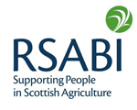The 2023 season at Upper Nisbet has again been dominated by the variation in the growing conditions. The 8.4 ha field with eight individual paddocks of straight perennial ryegrass varieties and mixtures has been grazed over the season with bulling heifers at a stocking rate of 2300kg LW per ha.
Rainfall was above average in March when 50kg of N + sulphur/ha was applied to the field and good growth built through April and peaked in mid May at over 100kg DM/ha day. Hobkirk series soil does not tend to hold moisture and deficits increased until the 18th June when some rain relieved the high temperatures and soil moisture deficit. The growth in that period had dropped down to 40kg DM/ha and only ever recovered to 60kg in mid August with average rainfall for the month of 64mm and 44mm in September.
The samples of grass we cut on 12th April for analysis had 12.4 average ME and 23.3 CP in the mixtures with clover but DM and quality had fallen away in August. Stock had to work harder to get their intakes with dry matter at an average of 12.5%.
As we entered the 5th year of the trials in September, it was a good chance to look at persistency in the single stand plots of ryegrass and to reflect on how the mixtures are performing.
Key finding after four years of full production:
1 - Persistency has started to show up the cliff edge that certain intermediate varieties show in their productivity. We have scored very noticeable differences in ground scores with more bare earth, weed and moss ingress. With our lower levels of nitrogen application and, particularly in the absence of white clover, this shows up starkly. Intermediate tetraploids are much more open than their diploid neighbours despite us using higher seed rates at establishment to try and achieve similar plant populations. The late varieties are better and some of the diploid material has kept impressive densities.
2 - We soil sampled the paddocks again in September to monitor for changes in status and used a similar sampling pattern to September 2019. The pH in the single stand paddocks had fallen by an average of 0.3 points to 6.4 and in the mixtures including the multispecies had fallen by only 0.1 to 6.5. Phosphate and potash levels have not fallen but both calcium and magnesium have dropped back by 15%. Organic matter has risen in the multispecies and mixtures to 5.5% from an initial sample at 4.8% on LOI in 2019. This is higher than the James Hutton Institute suggest is typical for this soil series at 20cm cultivated depth.
3 - The mixtures never look hungry or stressed with drought and you struggle to identify urine patches from a distance. The single stand species though, without clover, often look hungry and the dung and urine patches are noticeable unless you apply nitrogen to even things up. Weed ingress with docks is more prevalent in the monocultures of perennial ryegrass than in the mixtures with their density and competition.
4 - The endrigs on top and bottom had some plantain and chicory established from leftover seed in the hopper from paddock 8. The plantain has now appeared in the paddocks of straight ryegrass having flowered and the seed spread by the cattle as they graze. The chicory has declined in population in the multispecies paddock whereas yarrow has increased.
5 - Palatability between individual varieties is still very noticeable and the better clean outs and lower residuals leads to better quality at the subsequent grazing round.




